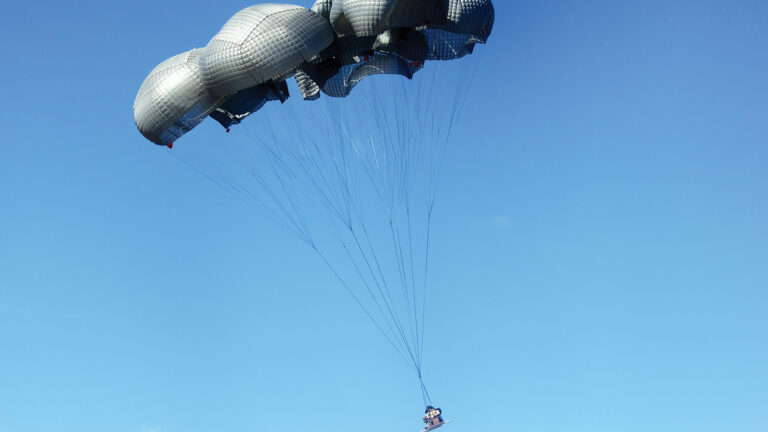Stay Up to Date
Submit your email address to receive the latest industry and Aerospace America news.
Meet the U.S. Army’s new parachute Six years of design work and field trials have brought a successful conclusion to the U.S. Army’s search for a better way to airdrop troops and heavy equipment into the field.
For 60 years, the conundrum has been this: The clusters of G-11 cargo parachutes that ease vehicles, ammunition and other supplies to the ground must be dropped from higher altitudes than the troops riding aboard the same plane or a nearby one. When troops are aboard, the cargo is pushed out the back of an aircraft such as a C-130, and then the pilot circles back at a lower altitude so the troops can ride to the ground under round steerable T-11 personnel parachutes.
Dividing the drops like this can be risky. “For forced entry capability, you want personnel and equipment on the ground at the same time, in the same pass, so you limit your exposure,” says Ben Rooney, an engineer, who managed the project as part of the U.S. Army Product Manager Force Sustainment Systems, or PM FSS, an Army program in Natick, Massachusetts, tasked with providing equipment, systems and technical support for soldiers.
Several years ago, the Army awarded a contract to Zodiac Parachute and Protection America (now Safran Parachute & Protection America, the U.S. offshoot of the French aerospace giant) and Fox Parachute Services of Belleville, West Virginia, to design a new kind of chute, now designated the G-16.
If the engineers could make each chute in the cluster inflate faster, less altitude would be lost and heavy cargo could be released closer to the ground. This is done with a smaller parachute in the mouth of each to force the canopy open.
Soon the Army will be able to make tactical insertions with one plane, in one pass.
In field tests with the G-16 in 2017, the Army achieved a 25% to 32% decrease in minimum altitude required for cargo drops. The G-16 can drop loads up to 10 metric tons (22,000 pounds) with one to four parachutes from 230 meters above ground level and loads between 10 and 19 metric tons (22,001 and 42,000 pounds) with five to eight parachutes from 300 meters.
PM FSS is finalizing a sustainment contract, meaning the first parachutes will be in the hands of troops in 2021, Rooney says.
The G-16 is the same diameter as the G-11, about 9 kilograms lighter and packs in the same bag. “It’s a true one-for-one replacement,” Rooney says.
The design offers another benefit. Because the canopy is made of square, diamond and elliptical modules that are hand-tied together, not sewn like the G-11’s long, triangular gores, it is easier to construct and repair. “The riggers can use their scissors or knife, and they can cut the ties, pull that module out, replace just the module and the canopy stays in service,” Rooney says.
About Christine Fisher
Related Posts
Stay Up to Date
Submit your email address to receive the latest industry and Aerospace America news.




